Here’s how to create a no-water yard by replacing grass with wood chips or mulch.
A few years ago, I created a no-mow front lawn. I covered over the grass with soil and planted hardy ground cover.
While I loved how it looked for the first year or two, over time it started to look overgrown and untidy. Also, it had beautiful bright colors and blooms in the spring, but just looked plain for the rest of the year.
I decided it was time to replace the ground cover. While I was at it, I tackled the other side of the front lawn as well, and create a no-water yard.
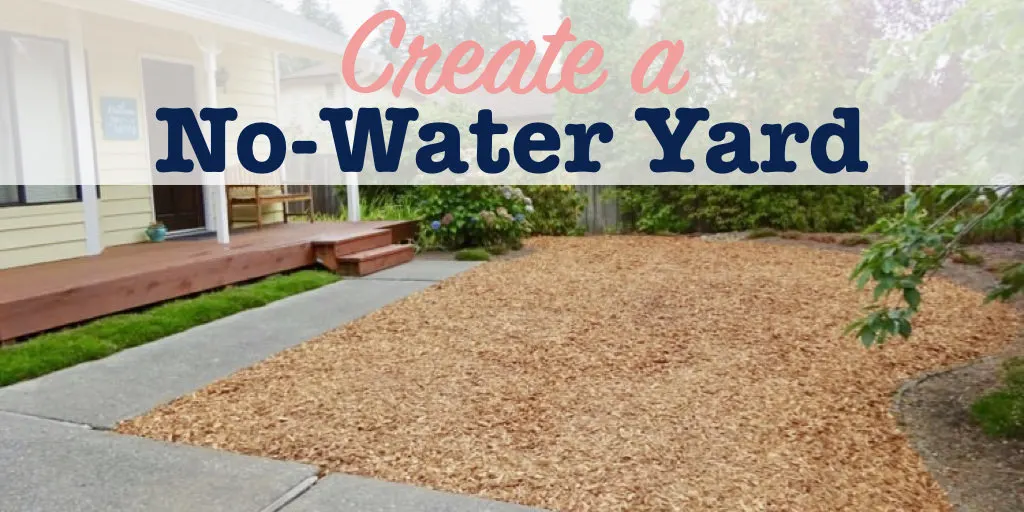
I wanted to make sure that I could do the project on my own without having to hire any contractors. And I didn’t want the project to cost lots of money, either. It turns out this was a relatively simple DIY to improve my outdoor living area.
You’ll want to see my inexpensive backyard makeover, too, which I did on my own!
How Much Will The Mulch Cost?
According to Home Advisor, the average cost of a cubic yard of mulch in 2021 is about $30.
Using bags of mulch will double the cost of this project. According to Home Advisor, the average cost of bagged mulch is $0.60 per square foot, while a truckload of mulch will cost about $0.30 per square foot.
How Many Cubic Feet Are in a Yard of Mulch?
There are 27 cubic feet in a cubic yard. Here’s a handy mulch calculator to help you figure out how many cubic yards you will need.
Are Wood Chips the Same as Mulch?
Wood chips are shredded, chipped or ground-up pieces of an entire tree. When used on the ground, they are considered mulch. So, yes, wood chips and mulch are the same thing. However, the prices can vary depending on how fine or coarse the mulch is, what type of tree is used, etc.
Here are all of my tips for how to get free wood chips to use as mulch.
Create a No-Water Yard
Before Pictures
Here’s what my front lawn looked like before I started this project. Brown, patchy, and full of weeds. (The weeds are the only green spots.)
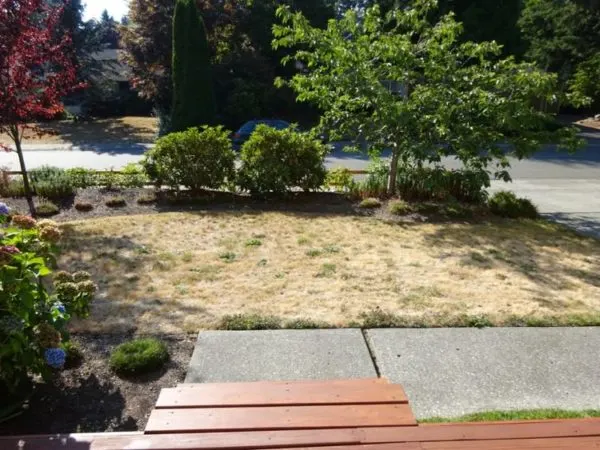
There is nothing attractive about this “lawn.” I don’t want to use a lot of water and weed killer to grow grass that just has to be mowed all the time.
On the other side of the driveway was my ground cover experiment to create a no-mow lawn with low growing vegetation.
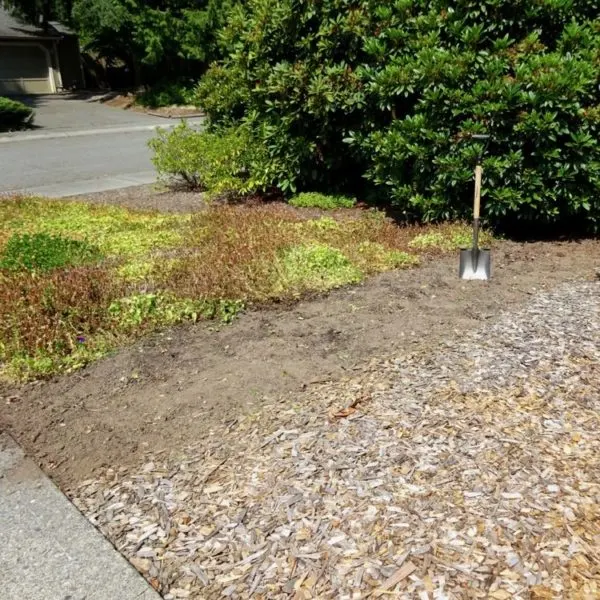
See what I mean about how it started to look overgrown? It took me many weekends to dig out all of the ground cover by hand.
It wasn’t fun work, but it was at least good exercise.
How I Replaced My Grass with Wood Chips
I decided to replace my lawn with wood chips. They make great ground cover, keep weeds down, create a very tidy appearance, and require no maintenance at all.
It’s the perfect no-water yard solution.
Here are the step-by-step instructions of how I did it.
1. Dig out the edges
To prepare the space, I started by digging out the existing lawn around the edges. Where the lawn (weeds) met the sidewalk or driveway, I dug it out with a shovel.
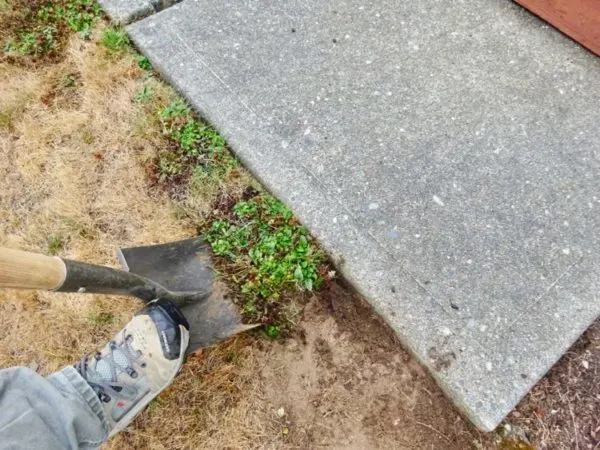
The reason for doing this was simply to lower the ground level a few inches. When the wood chips get spread on top, I don’t want them to spill onto the concrete.
2. Cover grass with cardboard
Since I didn’t want to dig out my entire lawn, once I was done digging out the edges, I just covered the rest with large pieces of cardboard. You can use old shipping boxes, or also several layers of newspaper.
In fact, newspaper prevents weeds growing in your garden, too. And it will kill grass if you use it as a ground cover.
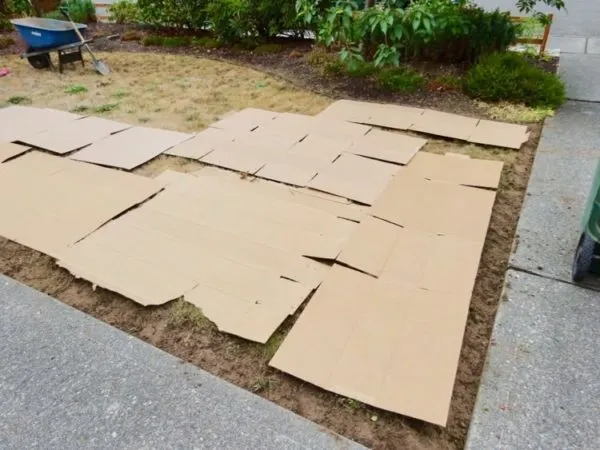
The cardboard will help keep the grass from growing up through your wood chips, and it breaks down over time. Using cardboard or newspaper is very important in this step! You cannot just add mulch over a lawn and expect it to die out.
The grass will actually start growing through the mulch (especially because mulch will hold in moisture, which will help the grass to actually start growing even more).
Cardboard will block sunlight from the grass, while still allowing water to seep through to the soil. Over time (about a year) it will decompose back into the Earth, but until then you want the cardboard to smother the grass.
Be sure to plan ahead for this.
I underestimated how much cardboard I would need, and my mom and I ended up asking my neighbors and people out walking their dogs if they had any old boxes we could have.
Helpful Tips I Learned:
- Layer the cardboard over each piece a few inches. You don’t want grass to grow through any gaps.
- Get lots of big cardboard from businesses that recycle their boxes. Or start stockpiling it for a while before you decide to smother your grass.
- Cardboard or newspaper is frustrating to put down when it is windy. Unless you can work in small sections, it’s best to avoid windy days. Or you will need to use landscaping pins to hold it down.
3. Get the wood chips delivered
I had a load of 4.5 cubic yards of wood chips delivered, and dumped directly onto the work area on one side of the driveway.
I highly recommend getting your materials delivered as close to your work area as possible, to save yourself the work of moving it! It is tough work trying to shovel the chips into a wheelbarrow and then move the wheelbarrow with all of the weight.
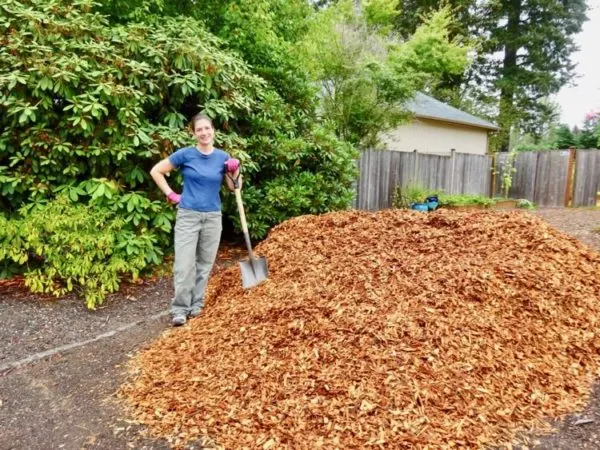
I have found that tree cutting services often will give you a load of wood chips for free if they are in your area. You might want to call local services and ask them about the options.
City government tree services or local municipalities might also give you free mulch, too. However, with these freebies you do want to be wary about mulch from diseased trees or from plants that could have seeds that will germinate. It’s not easy to know, but you might want to ask about the source of their wood chips.
If you need help figuring out how much material to buy, the companies that sell it often have calculators on their websites.
For a little more help planning your project, pick up a copy of the Single Girl’s DIY Project Planning Workbook. It includes the formulas for calculating material amounts, and guidance for planning out every step of your project.
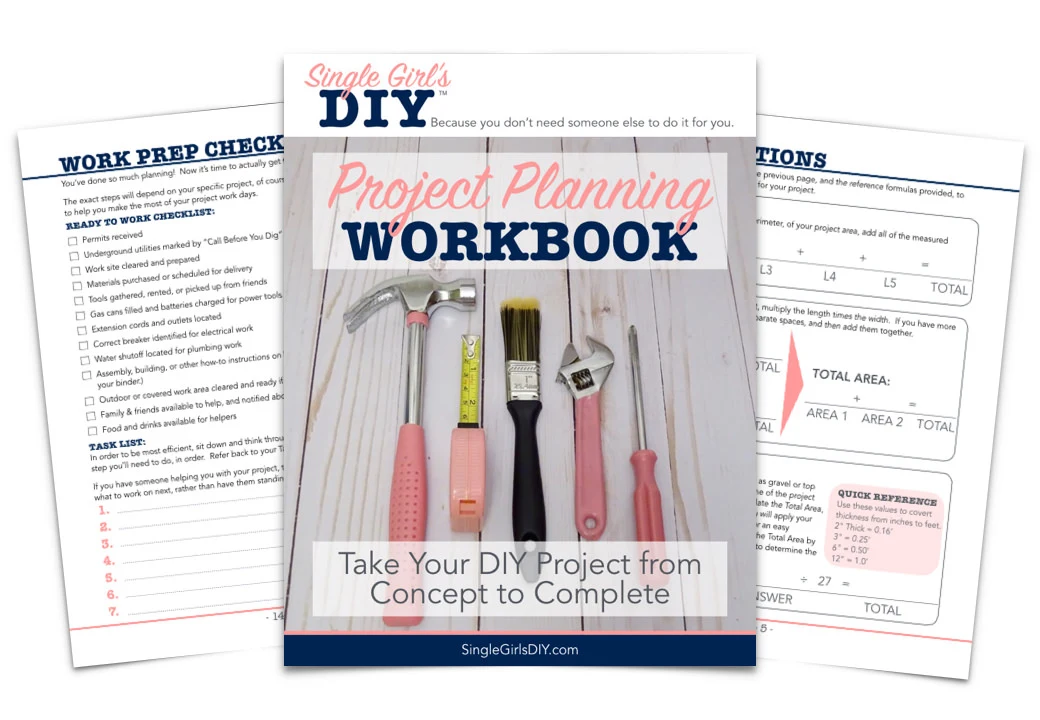
4. Spread the wood chips
The rest is just a lot of moving wood chips from one place to another. Use a shovel to fill up a wheelbarrow, and take it to where you want it in the yard. Then spread the wood chips out smoothly with a rake.
Repeat, repeat, repeat, repeat, repeat…
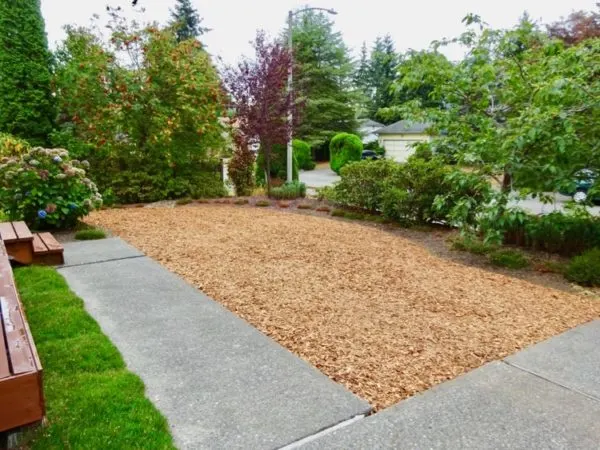
After Pictures
I love the result of my no-water yard. It is clean and tidy looking year-round, and requires no maintenance.
No mowing, no watering, no fertilizing, and no thatching!
Here are a few more pictures of my new wood chip front yard. (With a big thanks to my mom for helping me spread all of that mulch!)
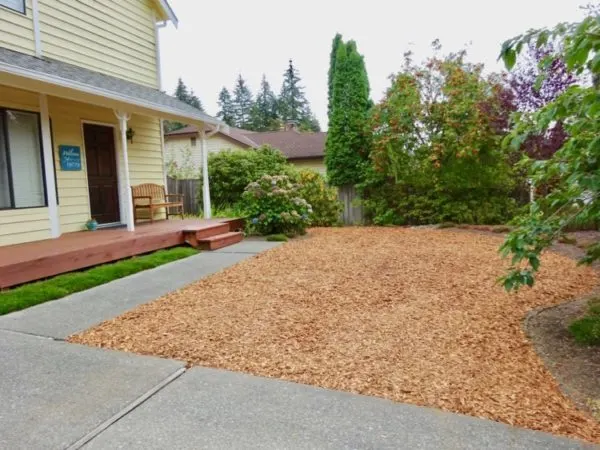
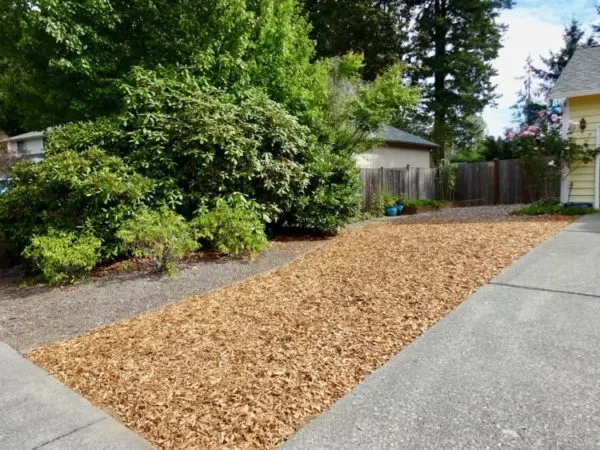
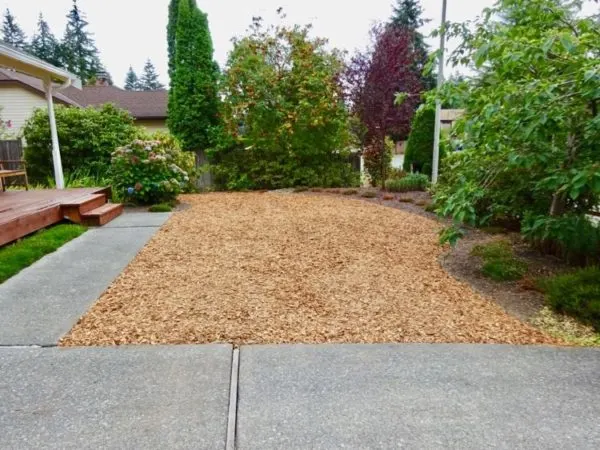
I chose to replace my front yard with coarse mulch. However, I’m not sure I’d do a wood chip backyard.
It’s not easy to walk through wood chips with bare feet. It’s not fun to play games of frisbee or throwing a ball around when you might fall into a pile of wood chips, rather than grass. It’s up to you.
I’ve found that a mulched yard doesn’t necessarily mean no maintenance at all. You do still need to weed occasionally. And after a few years, the mulch will naturally decompose so you will need to add another layer of wood.

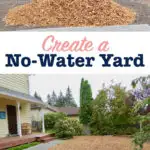

lawn started
Friday 25th of April 2025
I really enjoyed this guide—such a creative and practical approach to landscaping without the constant need for watering! It’s a great reminder that a beautiful yard doesn’t have to mean high maintenance or high water bills. For anyone who already has a lawn started but wants to transition to something more sustainable, this offers an inspiring roadmap. Thanks for breaking it down in a way that feels totally doable!
No
Tuesday 14th of March 2023
Very nice
Janice
Thursday 6th of October 2022
Thank you for this information. I have wanted to do a bark only front yard for a long time. But I have hesitated because I have large trees in the yard (deciduous and pine) and will need to water them sometimes. Would it be a good idea then to put plastic over the newspaper and/or cardboard? What do you suggest with regard to keeping the trees alive? Thank you!
Joanna
Thursday 4th of July 2024
@Janice,
Janice
Thursday 6th of October 2022
@Kimberly, Thanks, Kimberly, for the response -- very helpful!! Janice
Kimberly
Thursday 6th of October 2022
Janice, I wouldn't put plastic down. That would prevent natural rainfall from getting into the ground. If you feel like you need a layer underneath, then use newspaper or garden fabric, as that allows water to pass through. As for keeping the trees alive, I think you should plan on watering them when needed with a garden hose. You will still be using much less water than watering the yard. As your trees become more mature and established with a deeper root system, you won't have to water them much at all, depending on where you live.
Deirdre Henry
Saturday 19th of March 2022
What a great idea. Your garden looks terrific, so neat and tidy, most importantly of all, very low maintenance. If I was 30 years younger I'd have a go at doing the same in my garden. Well done. Deirdre
Kimberly
Friday 20th of May 2022
Thank you, Deirdre!!!
Berry
Friday 14th of August 2020
Hi Jenny, Another use of the front yard is a vegetable garden, but it wouldn't save watering, if that's the whole objective here. You can put cardboard over the lawn, build boxes (wood, stone, or any raised edging), and fill with garden soil. No tilling needed- the roots will find their way through. The chips between beds make lovely paths. Instant garden!
SingleGirlsDIY
Friday 14th of August 2020
Great idea! I think in many ways, the goal of a no-water yard is to not waste water by just keeping grass alive. However, if water is being used towards food production which will give you healthier food and save money, then the water is used wisely. Great idea about the boxes, thank you.